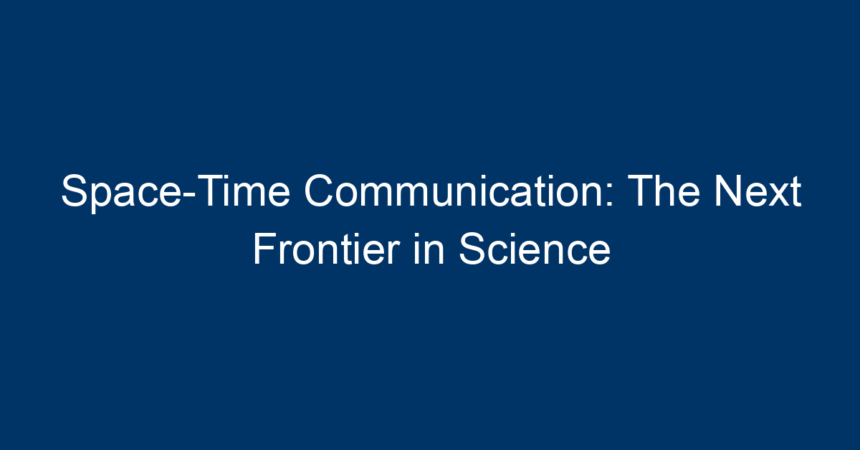Introduction
Imagine a world where communication transcends the boundaries of time and space. A realm where messages can travel across vast cosmic distances, connecting minds separated by light-years. This fascinating concept is not just the stuff of science fiction; it is at the cutting edge of modern scientific inquiry: space-time communication. As researchers delve into the complexities of quantum mechanics and the fabric of spacetime, new possibilities are emerging that could redefine our understanding of communication in the universe. In this article, we will explore what space-time communication entails, the scientific principles behind it, its potential applications, and the future outlook for this groundbreaking field.
Understanding Space-Time Communication
What is Space-Time Communication?
At its core, space-time communication refers to the theoretical ability to send information through spacetime in ways that significantly differ from conventional methods. Traditional communication relies on signals transmitted through various mediums, such as electromagnetic waves traveling through air or fiber optics. However, space-time communication posits that it may be possible to exploit the fabric of spacetime itself, utilizing phenomena such as wormholes, quantum entanglement, and the principles of relativity to send information instantaneously across vast distances.
The Science Behind Space-Time Communication
Quantum Entanglement
One of the pivotal theories in the realm of space-time communication is quantum entanglement. This phenomenon occurs when particles become intertwined in such a way that the state of one particle instantly influences the state of another, regardless of the distance separating them. This instantaneity challenges the classical understanding of space and time and lays the groundwork for potential communication methods that could bypass traditional limits.
Wormholes and Spacetime Curvature
Another key aspect of space-time communication is the concept of wormholes—hypothetical passages through spacetime that could create shortcuts between distant points in the universe. According to the theory of general relativity, these wormholes exist within the curved fabric of spacetime, and while they remain theoretical, their implications for communication are immense. If traversable wormholes could be created, it might enable instantaneous communication between distant galaxies.
The Role of Theoretical Physics
The advancement of space-time communication is heavily reliant on the principles of theoretical physics. Scientists are constantly exploring the most paradoxical ideas within quantum mechanics and relativity. This includes examining the behavior of particles at the quantum level and the implications of time dilation on communication methods. A deeper understanding of these concepts may ultimately yield innovative methods for transmitting information.
Applications of Space-Time Communication
Faster-than-Light Communication
One of the most revolutionary applications of space-time communication is the potential for faster-than-light (FTL) communication. Imagine being able to send messages to distant civilizations or space exploration missions in real-time, overcoming the significant delays inherent in light-speed limitations. This could not only enhance interplanetary communication but also open up new pathways for collaboration and progress in scientific Research.
Enhanced Data Transmission
In our increasingly interconnected world, data transmission is paramount. Space-time communication technologies could enable vast amounts of data to be transmitted instantaneously and securely. This could lead to advancements in virtual reality, augmented reality, and telepresence, providing users with immersive experiences that defy traditional limitations.
Interstellar Communication
The vastness of space presents challenges for current communication methods. Space-time communication offers a potential solution to contact potential extraterrestrial life forms. By utilizing quantum entanglement or theoretical wormholes, researchers can explore ways to send messages across light-years without suffering from time delays, effectively bridging the gap between Earth and distant civilizations.
Challenges in Space-Time Communication
Technological Limitations
Despite its potential, significant technological challenges remain in realizing space-time communication. Current understanding and technology are not advanced enough to manipulate the principles of quantum mechanics or general relativity to enable practical applications. Developing the requisite technology demands time, funding, and continued research.
Ethical Considerations
As with any groundbreaking technology, ethical considerations emerge alongside innovations in space-time communication. Potential misuse or the unintended consequences of enhanced communication capabilities must be thoroughly examined. Questions about privacy, security, and the societal impact of such technologies will need to be addressed to ensure responsible usage.
Scientific Skepticism
Theoretical physics often encounters skepticism, particularly when exploring concepts as radical as space-time communication. Many scientists remain cautious about the feasibility of such technologies, emphasizing the need for rigorous experimentation and validation before concrete conclusions can be drawn.
Future Outlook for Space-Time Communication
Advancements in Quantum Technologies
The future of space-time communication is inextricably linked to advancements in quantum technologies. As research proceeds in quantum computing, cryptography, and mechanics, we may uncover breakthroughs that bring us closer to real-world applications. This field is teeming with potential, with numerous avenues still waiting to be explored.
Collaboration and Multidisciplinary Approaches
For space-time communication to flourish, collaboration across various scientific disciplines is critical. Physicists, engineers, and computer scientists must work together to integrate insights from their respective fields, merging theory with practice. Interdisciplinary approaches are essential to developing the innovations needed to push the boundaries of what is possible.
Public Interest and Investment
As awareness of space-time communication grows, so may public interest and investment in the field. Increased funding could accelerate research and development, paving the way for technological advancements that were previously deemed impossible. Fostering a scientific culture that encourages exploration and discovery will be instrumental in shaping the future of space-time communication.
Conclusion
Space-time communication represents a bold hypothesis that has the potential to reshape our understanding of communication and connection in the universe. As we stand on the brink of a new scientific frontier, exploring the intricacies of quantum entanglement, wormholes, and the fabric of spacetime will continue to inspire researchers and dreamers alike. While we face technological challenges and ethical considerations, the pursuit of space-time communication is well worth the endeavor.
Actionable Insights
-
Engage with Research: Stay up to date with scientific research related to space-time communication. Following journals and attending conferences can provide insights into emerging findings.
-
Promote Interdisciplinary Collaboration: If you are in the scientific community, advocate for partnerships between disciplines to explore uncharted territories in space-time communication further.
-
Encourage Public Discourse: As a member of the public, engage in conversations about the implications of emerging technologies like space-time communication, fostering awareness and ethical considerations.
- Invest in Education: Support educational programs emphasizing quantum physics and theoretical science to cultivate a new generation of scientists equipped to explore concepts like space-time communication.
Space-time communication holds tremendous promise, and while we may not yet possess the technology to fully realize it, the journey promises to be as exciting as the destination itself.




